Fifteen ships of the Royal Navy have been named HMS Chatham after the port of Chatham, Kent, home of the Chatham Dockyard.

Sir Oswald Walters Brierly, was an English marine painter from an old Cheshire family and he was born at Chester.
Eight ships of the Royal Navy have been named HMS Royal George after various members of the House of Hanover. A ninth was renamed before being launched:

Frogmore House is a 17th-century English country house owned by the Crown Estate. It is a historic Grade I listed building. The house is located on the Frogmore estate, which is situated within the grounds of the Home Park in Windsor, Berkshire. Eight hundred meters south of Windsor Castle, Frogmore was let to a number of tenants until the late 18th century, when it was used intermittently as a residence for several members of the British royal family.

The Kingston Royal Naval Dockyard was a Royal Navy Dockyard from 1788 to 1853 in Kingston, Ontario, Canada, at the site of the current Royal Military College of Canada.

Joseph Whidbey FRS was a member of the Royal Navy who served on the Vancouver Expedition 1791–95, and later achieved renown as a naval engineer. He is notable for having been the first European to discover and chart Admiralty Island in the Alexander Archipelago in 1794.
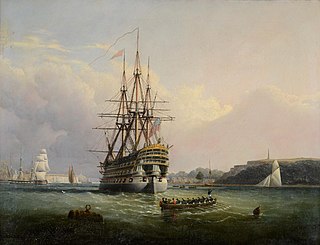
HMS Royal Adelaide was a 104-gun first-rate ship of the line of the Royal Navy, launched on 28 July 1828 at Plymouth.

Rear-Admiral Lord Adolphus FitzClarence was a British Royal Navy officer and illegitimate son of Prince William, the future William IV, and his mistress Dorothea Jordan. FitzClarence joined the navy in 1813. In the following year he joined a fourth rate which saw service in the War of 1812, including in the unsuccessful blockade and chase of USS Constitution. FitzClarence saw frequent service in the Mediterranean Sea. Coming under the patronage of Rear-Admiral Sir Thomas Fremantle, FitzClarence received further naval education from Commander William Henry Smyth and served in the Ionian Islands upholding British neutrality in the Greek War of Independence.
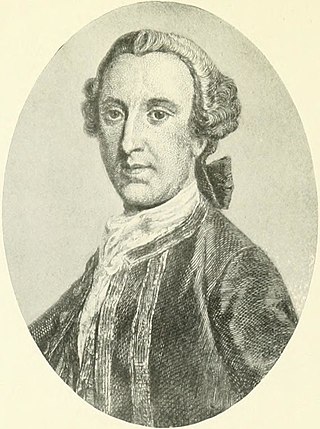
Admiral Sir Peircy Brett was a Royal Navy officer. As a junior officer he served on George Anson's voyage around the world and commanded the landing party which sacked and burned the town of Paita in November 1741. During the Jacobite rising Brett saw action on 9 July 1745, when as captain of the fourth-rate HMS Lion he exchanged fire with the French ships Elizabeth and the Du Teillay: the Du Teillay at the time was carrying Charles Edward Stuart to Scotland with supplies and funds to support his cause. Brett also commanded the third-rate HMS Yarmouth at the First Battle of Cape Finisterre in May 1747 during the War of the Austrian Succession. He commanded HMS Cambridge on the North America and West Indies Station during the Seven Years' War and later became Senior Naval Lord. He was also a Member of Parliament, representing the constituency of Queenborough from 1754 until 1774.
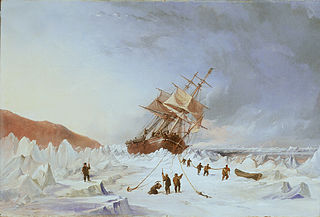
HMS Assistance was an Arctic discovery barque of the Royal Navy, and the sixth vessel to carry the name. She began in 1834 as the India-built merchant vessel Acorn. Her name was changed to Baboo. Under that name she transported contract labourers between Mauritius and India, and immigrants to South Australia. The Royal Navy purchased her in 1850 and named her HMS Assistance. Assistance participated in two Arctic expeditions before her crew abandoned her in the ice in 1854.

Admiral of the Fleet Sir George Martin was an officer of the Royal Navy who saw service during the American War of Independence, and the French Revolutionary and Napoleonic Wars. During his long naval career he took part in several significant battles, for which he was awarded a number of honours and promotions; he commanded ships at Cape St Vincent and Cape Finisterre.

Sir William Hotham GCB was an officer of the Royal Navy who saw service during the French Revolutionary and Napoleonic Wars.

James Rich Steers was an American yacht builder and politician. He founded the George Steers and Co shipyard with his brother, George Steers.

HDMS Kronprindsens Lystfregat was a yacht launched in Britain in 1785. George III gave it to his nephew Frederick, the Crown Prince of Denmark. Kronprindsens Lystfregat cost £10,347 to build and furnish.>
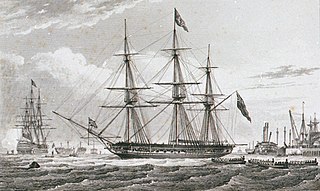
HMS Royal Sovereign was one of the royal yachts of King George III. She was the largest of his yachts and served from 1804 until she was broken up in 1849.
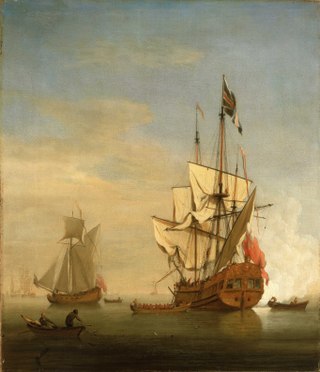
HMS Peregrine Galley was a 20-gun sixth-rate ship of the Royal Navy, built in 1699-1700 at Sheerness Dockyard by Master Shipwright William Lee to a design by Rear-Admiral the Marquis of Carmarthen. She was generally employed as a Royal yacht and in 1716 she was officially renamed HMS Carolina and converted to a permanent Royal yacht. In May 1733 she was rebuilt by Richard Storey at Deptford Dockyard as the Royal yacht and again renamed, this time as Royal Caroline. In 1739 she ceased to be the Royal yacht and resumed her classification as a Sixth Rate. In 1749 a new Royal Caroline was built to replace her. She reverted to being a naval sloop under the name HMS Peregrine and served until her loss on or about 28 December 1761.

Adelaide Cottage is a house in Windsor Home Park just east of Windsor Castle, in Berkshire. Built in 1831 for Queen Adelaide, it is currently the principal residence of the Prince and Princess of Wales.
Gordon Thomas Falcon was an officer in the Royal Navy. He first went to sea in 1794 as an able seaman on board HMS Sheerness. Quickly promoted to midshipman, Falcon transferred to HMS Repulse and then HMS Venerable, Admiral Adam Duncan's flagship, in which he served at the Battle of Camperdown.

Royal Adelaide was a royal yacht, designed as a miniature sailing frigate, which was built in 1833 and launched in the following year on the orders of King William IV of the United Kingdom, for use on Virginia Water Lake in Windsor Great Park in Surrey, England.


















